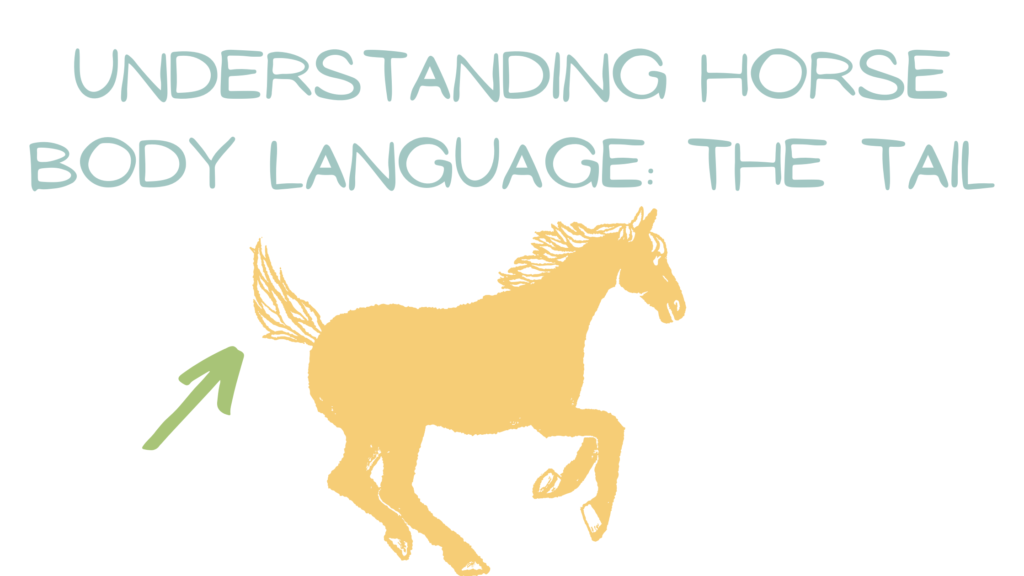
Understanding their body language is vital to successful relationships and care practices if you provide care for horses at your sanctuary. While horses have different vocalizations that communicate important information, their body language can also provide vital insight into their emotional states and health, but only if you can interpret them correctly! This resource is part of a series on horse body language and briefly introduces the different ways horses communicate with their tail. Through this series, you will learn to identify different meanings behind ear, head, tail, mouth, eye, and body positions and how context and the combination of these body positions can provide a fuller picture of what a horse is expressing. First, let’s take a general look at body language in horses before taking a closer look at tail positions specifically.
Body Language
Body language can help you better understand your resident’s wishes and emotional and mental states and help you identify signs of illness. Understanding a resident’s body language can allow you to catch early signs of illness or recognize social issues among the herd that may be negatively affecting a resident. Body language can also tell you much about a resident’s comfort level around different individuals and during different situations. Reading body language allows caregivers to tailor these situations and their own behaviors to meet the individual’s needs better. In short, body language is essential to know!
In horses, there are several elements of body language to pay close attention to: their ears, their mouth, their head, their eyes, their tail, their limbs, and their overall body position. While each of these areas can provide information about an individual, the whole of them read together will give the best overall interpretation.
But what do you look for in terms of tail position, and what can it mean? Let’s take a closer look!
Tail Positioning In Horses
You can tell a lot from looking at a horse’s tail!
If you care for horse residents, you know that their tails are generally long and covered by long, thick strands of hair. The base of their tail is composed of around 18 vertebrae (give or take a few depending on breed) with the hair growing out of it generally being much longer. Different breeds of horses may have tail hair that is different than others. Both genetics and environmental factors come into play here. While most horses have long, straight tail hair, some breeds may have wavy tail hair (like some draft horses), particularly long tail hair (like Friesians), shorter tail hair (like many appaloosas), or thick and bushy tail hair (think horses that evolved in cold regions, like Icelandic horses).



Horses often use their tails to swish away flies or other insects. They also use their tails as a form of communication. They may lift their tails up, stiffen them, tuck them close, leave them relaxed, or swish them around depending on the action they are performing and what they may be trying to communicate to others.
Abnormal Tail Conformation
Some horses may have a congenital defect or an injury that alters the conformation of their tail. As a result, their tail may not rise or move the same as a typical horse’s tail. Sadly, a horse’s tail may have been purposefully mutilated by docking, nicking, or blocking. There are cases where docking may be due to medical necessity, however, it is more often done to prevent a draft horse’s tail from interfering with carriage equipment or for cosmetic purposes in shows. Because some areas of horse “showing” give points for an erect tail or take away points for a flat tail, some humans have the horse’s tail “nicked” Nicking, sometimes referred to as pricking, is a procedure where certain tendons are cut, causing the tail to remain erect. There is another procedure called “blocking” that deadens the nerves, causing the tail to remain limp. This is done to prevent the horse from moving their tail if they feel uncomfortable, annoyed, or agitated during shows where points may be docked for restless tail movement. This is temporary, so it is less likely to be an issue with a horse resident unless the procedure was done immediately before taking them in.
In these cases, caregivers must take care to learn what movement their tail is capable of and what its position may mean for that individual. Understanding horse tail placement can also help you detect new injuries or illnesses and treat them swiftly. Applying a general concept of horse communication through tail placement may not be effective in situations where injury or disease prevents normal tail movement and could lead to misunderstandings and an unhappy resident. Remember, all residents are individuals, and while learning their species-specific behaviors is vital, so is learning about the individual. In that case, you would have to rely on other body language, the context of the situation, and vocalizations to understand what is being expressed.
While the whole meaning of tail positioning comes with context and understanding of tail, nose, mouth, eyes, body, and head positions (in addition to other things), there are some basic positions to know! You will see a bit later how the combination of the different positions can provide a fuller picture of what their body language is “saying.”
Neutral/Calm
A horse’s neutral tail will be relaxed, lacking tension, and laying vertically. They may be swishing it around if there are flies present. (This tail swishing to dissuade flies looks different than tail swishing seen when they are irritated or displeased). Their head may be up but relaxed in appearance, their body won’t be tense, and they will be aware but comfortable with their surroundings. You won’t see any tension in their cheek muscles or around their eyes, and you won’t see the whites of their eyes.
Their ears will be up but lack tension. Their ears may also turn out to the side a bit. Not droopy, but relaxed. You can distinguish this from dozing by observing the context and position of their tail, head, eyes, mouth, limbs, and/or body position. For example, suppose a resident is enjoying a nice nibble with a companion out in the field with their tail down and their ears up but not tense, turned towards sounds in the vicinity. In that case, there is a good chance they are feeling calm but paying attention to what is happening around them.


Relaxed And Dozing
If a horse’s tail is lax, laying vertically, and their ears are out to the side, aren’t holding any tension, their lips are drooping, their eyelids are relaxed or closed, and they are standing with a leg lifted slightly, they may be dozing. Be careful not to startle them by walking up to them unexpectedly. It is also important to learn the difference between a horse who is dozing while resting a leg and a horse who is holding up their leg due to pain or discomfort. A horse will be hesitant to put their full weight on a leg or hoof that is injured or if they have laminitis. Their gaitA specific way of moving and the rhythmic patterns of hooves and legs. Gaits are natural (walking, trotting, galloping) or acquired meaning humans have had a hand in changing their gaits for "sport". (how they walk) will look different and the hoof or leg may show signs of swelling, heat, or apparent injury. There are additional signs of pain to look out for as well. If you are concerned, consult your veterinarian as soon as possible.

Alert And Curious
If a horse resident is feeling alert and curious, their tail may stay laying vertically, still (if it had been swishing flies), or stiffen and be held out or up a bit, depending on their breed or level of interest/ curiosity. Their ears will be pricked forward (up and forward-facing). You might notice this when a resident sees someone coming into sight, hears a noise, or is otherwise alerted to or curious about a change in their environment. They will be lacking the tension in muscles around their eyes and cheek and body that would occur if they are concerned about a possible threat. They may stretch out their neck to sniff or otherwise investigate the subject of interest. If they reach out their neck towards a human or other horse and their ears are back and their lips pulled back this could be a sign of displeasure and a bite threat.
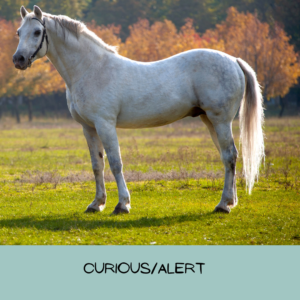
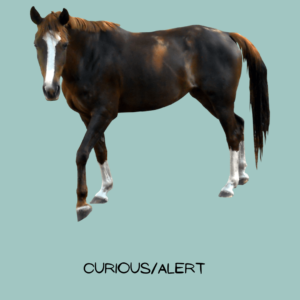
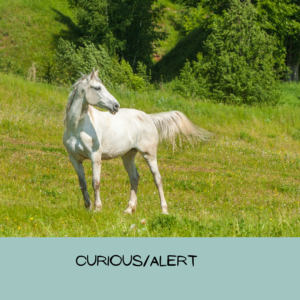
Alarmed/Excited/Fearful/Stressed
This one is a great example of why the overall body language must be taken into consideration. If a horse resident flags their tail (raises their tail high), they may be feeling excited and “spirited”. This is a sign of positive feelings. However, a horse resident may be truly alarmed by something and flag their tail. In this case, this would be a sign of negative feelings. It is important to look at other body language and the context of the situation. Are they prancing around the pasture when they catch sight of their companion returning from the vet? They may be eager, excited, and even a little anxious about reuniting with them quickly. Is their companion being led away and being loaded into a trailer? They may be seriously alarmed and afraid.
If a horse resident is feeling more alarmed than curious, their ears will still be up and forward-facing. However, there may be more tension in how they hold themselves. The position of their tail, head, mouth, and overall body position is often telling as well. Additionally, you may notice tension in their cheek muscles or muscles around their eyes. (We will cover this in future series.) The whites of their eyes might be visible. They may also pace or vocalize, alerting others to a potential threat or calling out to a companion they are separated from.
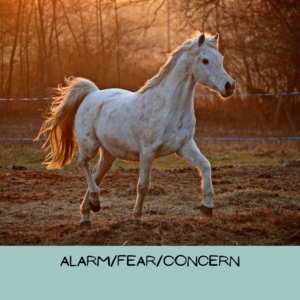

Additionally. if a horse resident is afraid, seriously stressed, or is exhibiting submission to another horse in their herd, they may clamp their tail between their legs. Other signs you might see that indicate fearfulness, anxiety, and stress are tension around their eyes and in their cheek muscles, the whites of their eyes being visible, or if they are attempting to back up, turn away, or pull away from a source of stress, among other signs. You may even notice them licking their lips as they generate more saliva in response to stress. Their ears may be laying back, forward but out to the side, or swiveling back and forth quickly.
Depressed/In Pain
A horse resident’s ear may lay back or droop out to the side, sometimes described as airplane ears, when depressed or in pain. As mentioned above, a horse resident’s ears may also seem a bit droopy when they are especially relaxed. Because of this, it is important to become familiar with each individual resident and learn how to identify signs of pain and depression. Disinterest in eating and/or engaging with companions can be a sign something is wrong, as can a lack of interest in/reaction to their environment. Check for signs of any obvious injury, if they are favoring a leg, have swollen, hot, or tender joints, or are pawing at the ground, biting at their sides, or rolling on the ground. The former can be signs of laminitis while the latter can be signs of colic.
Seriously Displeased/Confrontational
An especially displeased horse will swish their tail back and forth with vigor. This will look different than swishing their tail to rid themselves of flies and will be accompanied by other signs of displeasure or confrontationalBehaviors such as chasing, cornering, biting, kicking, problematic mounting, or otherwise engaging in consistent behavior that may cause mental or physical discomfort or injury to another individual, or using these behaviors to block an individual's access to resources such as food, water, shade, shelter, or other residents. behavior. They may pin their ears back. The further back their ears, the more unhappy they are with the situation. Their tail may also stiffen, raise and stick out a bit or, if they are preparing to buck or kick, their tail may be tucked in preparation. While all the above states should be taken seriously and steps should be taken to lower any discomfort or anxiety, this body language is a grave warning that they are especially displeased, and whatever is happening to make them feel threatened or uncomfortable should stop immediately before they begin defensive behaviors (pulling back, rearing, kicking, biting, and/or blindly fleeing) or offensive (kicking, biting, stomping, or charging) measures in an attempt to stop whatever it is that is upsetting them.
You may observe their head tucking down and their body bracing to kick out with their back legs or observe their head sticking straight out and their teeth bared to potentially bite someone. They may also swing their head in displeasure or lift their head and back up to try and remove themselves from the situation.
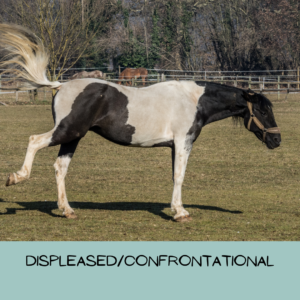

Reproductive Behaviors
Mares will lift their tails up and to the side when they are in estrous and ready to mate. (They may swish their tails vigorously if they are NOT interested in sexual attention). A stallion (intact male) or a gelding (neutered male) that retains stallion-like behaviors will stiffen and flag their tail during mounting and copulation.
Bathroom Behaviors
Horses don’t have bathrooms, but they do exhibit certain tail positions during defecation and urination. This looks like a raised tail, sometimes higher or lower depending on the sex of the individual and whether they are defecating or urinating. The good news here is you don’t have to wait long to understand this body language!
The Full Picture
As you may have noticed, sometimes ear position can look quite similar but be expressing different emotional states. In order to get the full picture of what a horse resident is trying to “say”, it is important to understand the context of the situation you are witnessing. While the above is a good introduction to horse body language and can certainly help you have a better idea of what your horse residents may be experiencing or expressing, you will learn through this series on body language that context is important, as is having a good understanding of horse behavior and recognizing nuances in body language and behavior. Knowing about ear, tail, head position, and body posture, as well as eye, nose, and mouth movements, will allow you to have a clearer picture of what is being “said”. For now, observe your horse residents and see what their ears are telling you!
SOURCES
Understanding Your Horse’s Body Language | RSPCA
The Basics of Equine Behavior | Rutgers University (Non-Compassionate Source)
Welfare Implications Of Horse Tail Modifications | American Veterinary Medical Association
Equine Body Language: 7 Signs to Recognize | The Horse (Non-Compassionate Source)
Equine Behavior: A Guide For Veterinarians And Equine Scientists | Paul McGreevey, Professor Of Animal Behavior And Welfare, University Of Sydney (Non-Compassionate Source)
EquiFACS: The Equine Facial Action Coding System | PLOS ONE (Non-Compassionate Source)
Horse Reactions To Human Attitudes And Behavior |Antrhozoös (Non-Compassionate Source)
What Do Ears Positions Tell Us About Horse Welfare? | Ethologie Animale Et Humaine (Non-Compassionate Source)
Facial Expression And Oxytocin As Possible Markers Of Positive Emotions In Horses | Scientific Reports (Non-Compassionate Source)
Horse Body Language | Extension Horses (Non-Compassionate Source)
Non-Compassionate Source?
If a source includes the (Non-Compassionate Source) tag, it means that we do not endorse that particular source’s views about animals, even if some of their insights are valuable from a care perspective. See a more detailed explanation here.








